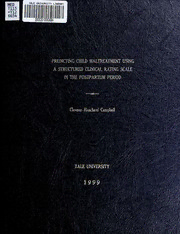
Predicting child maltreatment using a structured clinical rating scale in the portpartum period PDF
Preview Predicting child maltreatment using a structured clinical rating scale in the portpartum period
YALE UNIVERSITY CUSHING/WHITNEY MEDICAL LIBRARY Permission to photocopy or microfilm processing of this thesis for the purpose of individual scholarly consultation or reference is hereby granted by the author. This permission is not to be interpreted as affecting publication of this work or otherwise placing it in the public domain, and the author reserves all rights of ownership guaranteed under common law protection of unpublished manuscripts. Signature of Author Date Predicting Child Maltreatment Using a Structured Clinical Rating Scale in the Postpartum Period A Thesis Submitted to the Yale University School of Medicine in Partial Fulfillment of the Requirements for the Degree of Doctor of Medicine By Clovene Hanchard Campbell 1999 M<?d Li 'll 13 3YiZ U3{ YA!F Mrn,<W 1 Abstract PREDICTING CHILD MALTREATMENT USING A STRUCTURED CLINICAL RATING SCALE IN THE POSTPARTUM PERIOD Clovene Hanchard Campbell, John M. Leventhal, Denise I. Kung, Domenic V. Cicchetti, and Rachel Cohen. Department of Pediatrics, Yale University School of Medicine and Yale-New Haven Hospital, New Haven, CT Digitized by the Internet Archive in 2017 with funding from Arcadia Fund https://archive.org/details/predictingchildmOOcamp Few studies of perinatal predictors of child maltreatment have examined the predictive validity of a rating scale or have used the scale to structure clinical judgment to identify high-risk families. Therefore, we conducted a cohort study to test the predictive validity of the Kung-Leventhal Parenting Scale (K-L), a 22-item rating scale used to provide structure to clinical judgment in the postpartum period to identify newborns at risk of maltreatment. During the postpartum period, clinicians completed the K-L on a consecutive sample of 363 infants who were bom between November 1989 and September 1990 and planned to use the hospital’s primary care center for pediatric care. Based on scoring criteria for inclusion in the study, 159 infants were eligible, 50 of whom were categorized as moderate/high risk and 109 as low risk infants. Items on the K-L were based on maternal characteristics, paternal characteristics, maternal-infant interactions, and stability of the home environment. Each item was scored by a clinician (pediatrician or social worker) on a 4-point scale from 0 to 3, and an infant was categorized as moderate/high risk if the arithmetic sum of the scores was > 9. Fifty of the no/low risk sample were randomly selected for comparison with the moderate/high risk group. After excluding children who had not received health care in the New Haven area, we reviewed the medical records of 92 children at four health care sites (the only two hospitals and two neighborhood health centers) from birth to the fourth birthday to determine the outcomes of maltreatment, major changes in the child’s caretaker, and growth concerns. Using predefined criteria, events were classified as maltreatment (abuse, neglect and/or abandonment) or unintentional injuries by two clinicians, one of whom was blinded to the child’s risk status.
